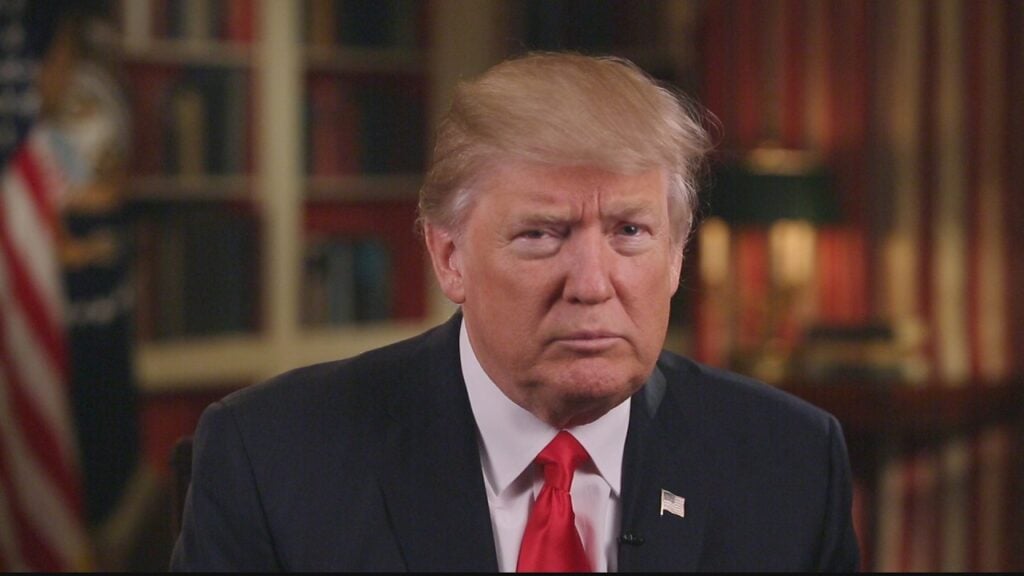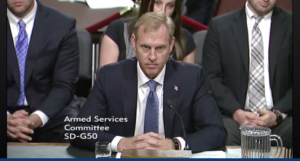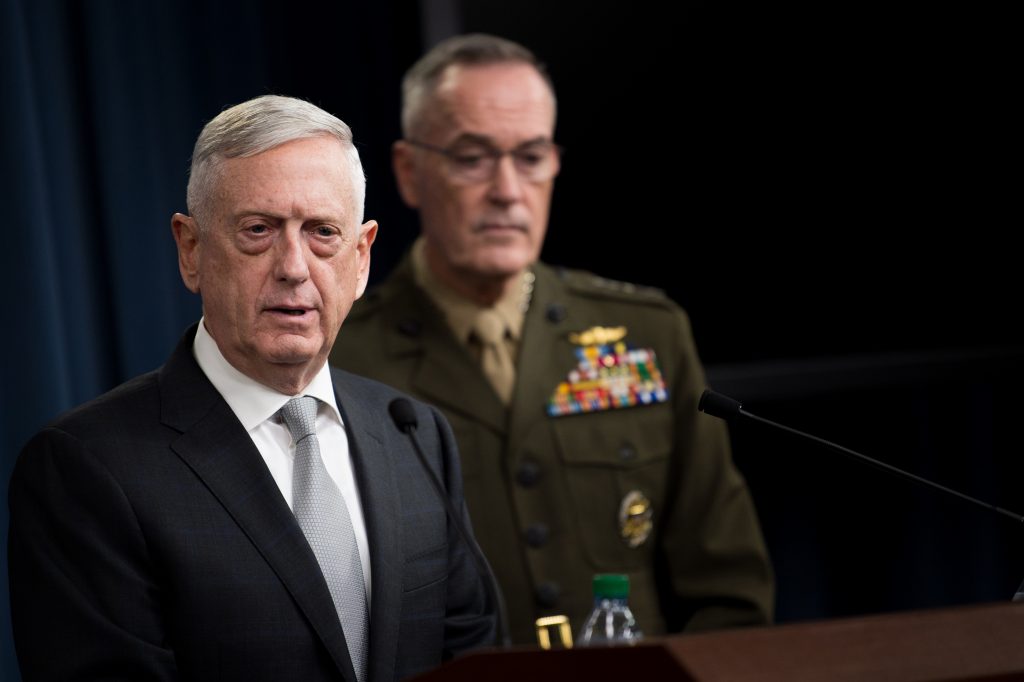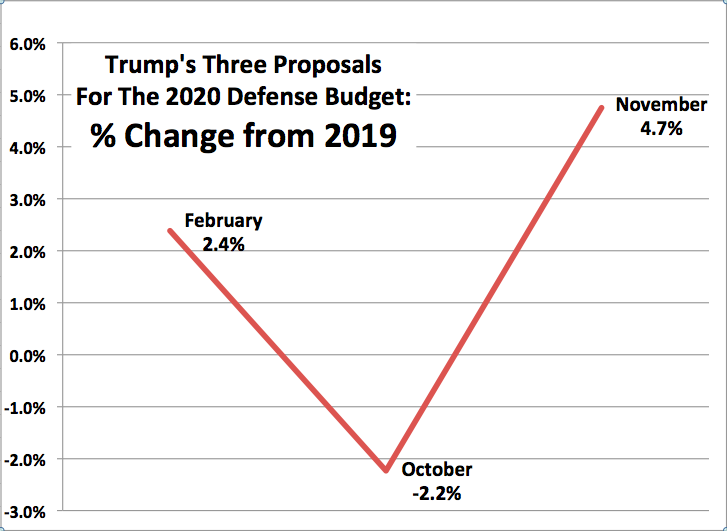By MARK CANCIAN
 It’s been a frenetic fall for the Department of Defense: a budget cut and then a budget increase, the secretary’s resignation and then his dismissal, an affirmation of allies and then a denunciation. What does this year-end craziness say about the year ahead? Here’s what to watch for:
It’s been a frenetic fall for the Department of Defense: a budget cut and then a budget increase, the secretary’s resignation and then his dismissal, an affirmation of allies and then a denunciation. What does this year-end craziness say about the year ahead? Here’s what to watch for:
Trump’s pick to replace Sec. Jim Mattis will be a key indicator about where the president wants to drive the department — and the confirmation process will show what the Senate will accept.
The National Defense Strategy issued in January, once thought to be firm, may now be in question.
The defense budget may be collateral damage from a bitterly divided Congress.
Finally, congressional investigations will both highlight key policy issues and add to partisan rancor.
Let’s focus on two of these points in particular.
Secretary of Defense Jim Mattis — gone as of Jan. 1st. — and the Chairman of the Joint Chiefs of Staff, Gen. Joseph Dunford — who’ll depart in 2019.
The Nomination Drama
Assuming no further surprises from President Trump — never a safe bet — the first national security issue of the new year will be the drama around the nomination and confirmation of a new secretary. Jim Mattis’s departure began as a relatively routine departure in an administration that has had a lot of cabinet turnover. Speculation had been rising for months that Mattis might leave, and he had served the average two-year tenure for secretaries of defense. While many commentators viewed Mattis’s resignation with concern because he was seen as an experienced and moderating voice in an erratic administration, his plan to stay until the end of February allowed a smooth transition.
But then the president seems to have actually read the resignation letter, or at least had Fox commentators draw his attention to how it implicitly criticizes his disparagement of allies and his weak stand against Russia and China. Further, the letter subtly snubs the president. Such letters customarily thank the president for the opportunity to serve and for his support during the incumbent’s tenure. Mattis’s letter twice states his appreciation for the opportunity to serve the nation and the men and women in uniform, but it never mentions the president. So Trump essentially fired Mattis, effective the end of December.
Patrick Shanahan
 Meanwhile, deputy secretary Patrick Shanahan will take the reins. Although he has superb qualifications in the defense industry, he has little experience dealing with the White House, Congress, the allies, military operations, or the intelligence community — and he lacks Mattis’s stature with any of them.
Meanwhile, deputy secretary Patrick Shanahan will take the reins. Although he has superb qualifications in the defense industry, he has little experience dealing with the White House, Congress, the allies, military operations, or the intelligence community — and he lacks Mattis’s stature with any of them.
The choice of an ultimate successor will be a signal about the future of national security policy and strategy. Most changes of secretaries of defense bring in new personalities but, absent a change of administration, not major changes in policy. The last mid-term appointment that signaled such a change was the departure of Rumsfeld and the arrival of Gates, which signified a major shift in the course of the wars in Iraq and Afghanistan.
Several names have been rumored as a possible replacement. A Washington Postarticle back in September mentioned General Keane, former vice chief of the Army; Sen. Tom Cotton of Arkansas; Sen. Lindsey Graham of South Carolina; businessman and former Treasury Department official David McCormick; and former Missouri Sen. Jim Talent. All of these come out of the conventional national security community and could be expected to continue the major elements of Mattis’s National Defense Strategy, though perhaps with different emphases. By contrast, the nomination of someone with few links to past national security policies might signal a departure from the strategy. Further, Trump seems to rate personal loyalty very highly and may pick someone with that quality uppermost.
In firing Mattis, Trump tweeted his disagreement about the allies:
….We are substantially subsidizing the Militaries of many VERY rich countries all over the world, while at the same time these countries take total advantage of the U.S., and our TAXPAYERS, on Trade. General Mattis did not see this as a problem. I DO, and it is being fixed!
— Donald J. Trump (@realDonaldTrump) December 24, 2018
This disagreement is hardly unexpected because Trump announces it at every allied summit conference. However, Mattis was able to smooth things over behind the scenes. Further, US policy on the ground has been remarkably unchanged. Despite concerns about Trump’s firmness against Russia, the U.S. European Deterrent Initiative, which began under the Obama administration to reassure allies in Eastern Europe, has grown to $6.5 billion in FY 2019. Similarly, US military actions against China in the Western Pacific have also grown. Arguably, the administration’s bifurcated approach has been successful, with Trump pushing the allies to spend more for their own defense, which they had been doing slowly, and Mattis reassuring them about US commitments.
All this could change if the next secretary implements Trump’s transactional view of the alliances. We’ve already seen Trump’s willingness to overrule his advisors in his decision to withdraw from Syria and reduce troops in Afghanistan. He may be becoming more comfortable about giving direct guidance and going with his gut. If so, and especially if encouraged by a more compliant secretary of defense, that could entail a real change in U.S. national security policy.
SOURCE: news reports
The Budget Drama
As soon as the drama about installing a new secretary of defense subsides — or quite possibly sooner — the drama about the FY 2020 budget will begin. The administration will almost certainly propose a $750 billion national security budget (in rough numbers, $650 billion for the DOD base budget, $70 billion for war funding aka Overseas Contingency Operations, and $30 billion for Energy Department nuclear programs), that being the last number to emerge from the administration’s chaotic budget review last fall. It is now too late to change the top line number without delaying the submission of the budget.
The likelihood of Congress approving a $750 billion budget is low, both because Democrats have retaken the House and because Trump himself signaled that the 750 figure was a negotiating tactic to get the original $733 billion proposal. But even the $733 billion budget could be collateral damage from the bickering of a partisan Congress. Fiscal year 2019 was the first time in a decade that DOD experienced “regular order,” in that both the authorization bill and the appropriation bill were signed before the beginning of the fiscal year. That occurred because the president and the Congress had made a budget deal last February covering FY 2018 and FY 2019. It is highly uncertain whether they could make a similar deal for FY 2020 and FY 2021 now that the Democrats control the House.
Rep. Adam Smith, incoming chairman of the House Armed Services Committee
 Caps from the Budget Control Actcontinue in FY 2020 and FY 2021 and, if implemented, would cut about $100 billion a year from the planned amounts. That’s not going to happen. In every year since the Budget Control Act began, the president and the Congress have come to an agreement to fund defense at levels above the caps. The question is, how much above the caps?
Caps from the Budget Control Actcontinue in FY 2020 and FY 2021 and, if implemented, would cut about $100 billion a year from the planned amounts. That’s not going to happen. In every year since the Budget Control Act began, the president and the Congress have come to an agreement to fund defense at levels above the caps. The question is, how much above the caps?
For many years, the Republican leaders in Congress—Sen. McConnell and Congressman Ryan—have been willing to increase domestic spending in order to get an increase in defense spending and keep the government running. That was good for defense, albeit bad for the deficit. Now, the president has shown a willingness to shut down the government in order to get his way, and the Democrats in Congress, particularly their increasingly assertive left wing, may not be willing to make the same deal. Stalemates, continuing resolutions, and brinksmanship seem likely.
Adding to the political turmoil, next fall, a large number of Democrats, maybe a few Republicans, will develop a new interest in Iowa’s agricultural policy and New Hampshire’s scenery and spend large amounts of time in both states to build a presidential campaign. That will involve a lot of political posturing in order to appeal to a highly partisan base and distinguish a candidate from the rest of the pack. If rhetoric and partisanship remain on the campaign trail, it will provide grist for political commentators but not affect defense. If it spills over into congressional action, then the stalemate might harden.
My guess is that we have seen peak defense budgets and that the eventual compromise will be around $716 billion for FY 2020, the same as FY 2019 (a DOD base budget of about $616 billion, war funding of $70 billion, and DOE nuclear funding of $30 billion). That is an obvious point of compromise between Republicans who want increased defense and Democrats who want to constrain it. The war funding (aka OCO), which isn’t restricted by Budget Control Act caps, could enable an agreement by allowing more defense spending without increasing the BCA-constrained base budget, as the Congress has done in the past. In any case, notions about moving enduring war funding from OCO to the base, as both the Obama and Trump administrations have suggested in the past, are likely dead since the benefit to good budgeting policy is not worth the political capital that would be needed to make the deal.
F-35 production line
 Defense modernization is particularly vulnerable here because it is relatively easy in the short term to cut investment in the future force, rather than operations, maintenance, and personnel costs for the force already in existence. Historically, modernization funding has risen more steeply than other accounts when budgets rise and fallen more steeply when budgets decline. This effect will be heightened because the administration has committed so powerfully to readiness, which might otherwise take some of the budget reductions.
Defense modernization is particularly vulnerable here because it is relatively easy in the short term to cut investment in the future force, rather than operations, maintenance, and personnel costs for the force already in existence. Historically, modernization funding has risen more steeply than other accounts when budgets rise and fallen more steeply when budgets decline. This effect will be heightened because the administration has committed so powerfully to readiness, which might otherwise take some of the budget reductions.
Higher budget levels, like the $750 billion level last directed by Trump, would allow DOD to fund new initiatives like next-generation missiles, aircraft, ground vehicles, and ships and still sustain legacy platforms in these areas. Lower budget levels will put pressure on both and require some trade-offs. There would be fewer new starts and some legacy systems would either be retired or cut off from sustainment. Particularly vulnerable would be A-10 ground attack planes, KC-10 tankers, and B-1bombers in the Air Force, CH-47 helicopters and Bradley armored vehicles in the Army, and CG-47 cruiser modernization in the Navy, because all of these have been on previous cut lists.
Finally, as noted here before, the House will become much more aggressive, and partisan, in conducting investigations of the administration. While most of these investigations will involve Trump’s finances and business dealings, a few will relate to defense. In particular, policy regarding Saudi Arabia, arms sales, and use of military force will come under scrutiny. These will highlight real policy differences but also contribute to partisan rancor. It’s going to be a wild ride.


No comments:
Post a Comment